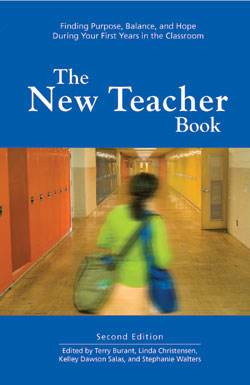As you prepare for a new school year, we wanted to share this short article by Rethinking Schools editor Larry Miller. While he is no longer in the classroom day-to-day, he continues to advocate for equity and social justice in education in his role as an elected school board member in Milwaukee, Wis.
His essay is included in the second edition of The New Teacher Book: Finding Purpose, Balance, and Hope During Your First Years in the Classroom. Get the book at a 25% discount with back-to-school discount code SchoolH12.
Download and share a copy of “12 Tips” (pdf). And share in the comments what tips you would add.
12 Tips for New Teachers
by Larry Miller
I was 38 when I started my teaching career, and I thought I knew everything I needed to know. I’d been a community and union activist for years and I’d been political all my life. I figured all I had to do was bring my experience and politics to the classroom and I’d be a great teacher.
Was I wrong. Now I’ve been teaching high school for more than 19 years and I continue to be humbled. When I work with new teachers, I give them the following suggestions:
- Keep calm in all situations. Calmness allows you to make rational decisions. If a student is confrontational or out of control, it never ever works to react with anger. Getting into a tug-of-war over who has the last word exacerbates the situation. Let the situation cool down and then try to have a mature conversation with those involved.
- Make respect central to your classroom culture. A common expression I hear from my students and parents is “You have to give respect to get respect.” They’re right. The only way to hold students to high and rigorous expectations is to gain their respect and their acknowledgment that your class will lead to real learning that will benefit them.
- Base your curriculum on social justice. Frame it with a critical edge. I have four questions for assessing my curriculum:
- Does the curriculum deepen students’ understanding of social justice?
- Is the curriculum rigorous?
- Are students learning the skills they need to be critical thinkers, advance their education, be prepared for employment, and become active citizens?
- I am also now forced to ask the question: Does the curriculum increase students’ ability to do well on state-mandated standardized tests?
- Keep rules to a minimum but enforce them. Always have clear consequences and never threaten to take a particular action if you are not willing to carry it out. Talk to students as mature young adults.
- Whenever possible, connect your classroom discussions and curriculum to students’ lives, community, and culture. Learn as much as you can about your students. For example, I use hip-hop lyrics as a means to discuss current trends of thought and worldviews in my citizenship class. Rappers offer plenty to discuss, both positive and negative. I get lyrics from the internet, I borrow CDs from students, and I search for positive rap on TV and the radio.
- Learn from other teachers and staff. Pay special attention to teachers and staff whose cultures and backgrounds are different from yours. I’ve always made a point of consulting every day with my colleagues. Their insight can be invaluable.
- Build students’ confidence in their intelligence and creativity. I’ve often heard my students call kids from the suburbs or those in AP classes “the smart kids.” Don’t let that go unchallenged. I start the year talking about “multiple intelligences” and how “being smart” can take many forms. I find daily examples of students’ work and views to talk about as smart and intelligent.
- Distinguish between students’ home language and their need to know “standard” English. Work with both. This is a huge topic, one you will be dealing with throughout your career.
- Keep lecturing short. Have students regularly doing projects, reading, giving presentations, engaging in discussions, debating, doing role plays, and taking part in simulations.
- Have engaging activities prepared for students when they walk into the classroom. I might play a piece of music, put an African expression on the board to interpret, or put students in “critical thinking groups” to solve a puzzle.
- Call students’ homes regularly both for positive and negative reports. Visit their homes. Students often belong to nonschool organizations. For example, during Black History Month many churches in the black community have special programs that students perform in. Attend, and go to other presentations given by groups they belong to.
- Mobilize students to join in new experiences. For example, I sponsor a “polar bear club”: We jump into Lake Michigan to celebrate New Year’s Day, then we all eat breakfast together.
What tips would you add to Larry’s list?
Related Resources:
- Introduction to Rethinking Our Classrooms, Vol. 1: “Creating Classrooms for Equity and Social Justice“
- Rethinking Multicultural Education, edited by Wayne Au.
- “Ebonics and Culturally Responsive Instruction” by Lisa Delpit. From Rethinking Schools magazine, Fall 1997

